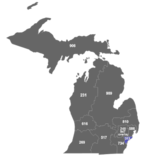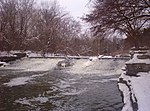Fort Wayne mound site
Archaeological sites in MichiganHistory of Wayne County, MichiganLate Woodland periodUse mdy dates from June 2020
The Fort Wayne mound site was a prehistoric burial mound located on the grounds of the Ordinance Department of the former Fort Wayne in Detroit, Michigan. It was one of a series of mounds in Detroit, including the Springwells Mound Group, the Carsten mound and the Great mound at the River Rouge. By the mid-20th century only the Fort Wayne mound was still standing. Today, the remains of the mound—located near Officers' Row—is fenced off to visitors.
Excerpt from the Wikipedia article Fort Wayne mound site (License: CC BY-SA 3.0, Authors).Fort Wayne mound site
Jefferson Avenue West, Detroit
Geographical coordinates (GPS) Address Nearby Places Show on map
Geographical coordinates (GPS)
| Latitude | Longitude |
|---|---|
| N 42.299166666667 ° | E -83.097222222222 ° |
Address
Fort Wayne
Jefferson Avenue West 6053
48229 Detroit
Michigan, United States
Open on Google Maps








